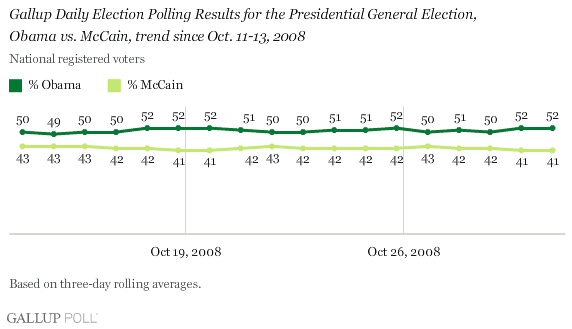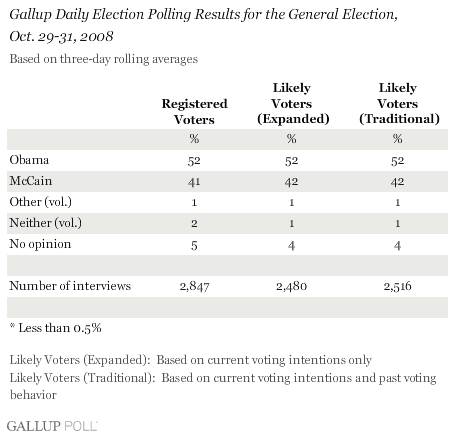PRINCETON, NJ -- Barack Obama leads John McCain in Gallup Poll Daily tracking interviewing conducted Wednesday through Friday by an identical 52% to 42% margin among both traditional likely voters and expanded likely voters. Obama leads by a similar 52% to 41% margin among all registered voters.


This is the first time since Gallup began estimating likely voters in early October that there is no difference between Gallup's two likely voter models. Obama's lead of 52% to 42% using Gallup's traditional estimate of likely voting criteria takes into account past voting as well as current intentions. Obama's identical lead using the expanded model takes into account only current voting intentions.
Both of these likely voter estimates in turn are almost identical to Gallup's 52% to 41% registered voter estimate.

In a general sense, the candidate preferences of the broad group of all registered voters have been remarkably steady for over two weeks now, showing little fluctuation despite both candidates' intense campaigning, the huge amount of news coverage of the election, and high levels of voter attention to the election. Obama's percent of the vote among registered voters has varied only between 50 -52% for the last 16 days, and McCain's has varied only between 41-43%.
Gallup's estimates of likely voters show more variation; these calculations take into account not only candidate preferences, but also the individual respondent's interest in the election, self-reports of intention to vote, and for the traditional model, reports of past voting history and knowledge of voting procedures. The average Obama lead over McCain among traditional likely voters since Oct. 6 has been five points, but that lead has expanded over the last several day's reports, and Obama's current 52-42% lead among this group is the largest to date. Gallup has increased its estimate of turnout in the election slightly to 64% (from the previous 60%), based on internal calculations which point toward the higher turnout number, and this 64% estimate is reflected in the traditional likely voter calculations.
Gallup's interviewing conducted Wednesday through Friday shows that 27% of registered voters who plan to vote have already voted. The trend in early voting has trended consistently upward on a day to day basis, moving from 7% of registered voters, who had already voted during the period of Oct. 17-19, to the current estimate of 27%. Another 8% of registered voters still indicate that they plan on voting before Election Day itself. The vote choices of these early voters -- all of whom are included in the likely voter pool since they are definite voters -- skew more toward Barack Obama than the sample average. Thus, more and more of these Obama-oriented voters' choices are being "locked in" to the likely voter pool through early voting, benefiting Obama. (To view the complete trend since March 7, 2008, click here.) -- Frank Newport

(Click here to see how the race currently breaks down by demographic subgroup.)
Survey Methods
For the Gallup Poll Daily tracking survey, Gallup is interviewing no fewer than 1,000 U.S. adults nationwide each day during 2008.
The general-election results are based on combined data from Oct. 29-31, 2008. For results based on this sample of 2,847 registered voters, the maximum margin of sampling error is ±2 percentage points.
Results based on "traditional" likely voters (based on the model taking into account current voting intention and past voting behavior) include interviews with 2,516 voters, and assume a turnout of 64% of national adults. The likely voter sample is weighted to match this turnout assumption, so the weighted sample size is 1,947. The associated maximum margin of sampling error is ±3 percentage points.
For results based on the sample of 2,480 "expanded" likely voters (based on the model taking into account current voting intention only), the maximum margin of sampling error is ±2 percentage points. The expanded likely voter model does not make any assumptions about turnout level.
Interviews are conducted with respondents on landline telephones (for respondents with a landline telephone) and cellular phones (for respondents who are cell phone only).
In addition to sampling error, question wording and practical difficulties in conducting surveys can introduce error or bias into the findings of public opinion polls.
